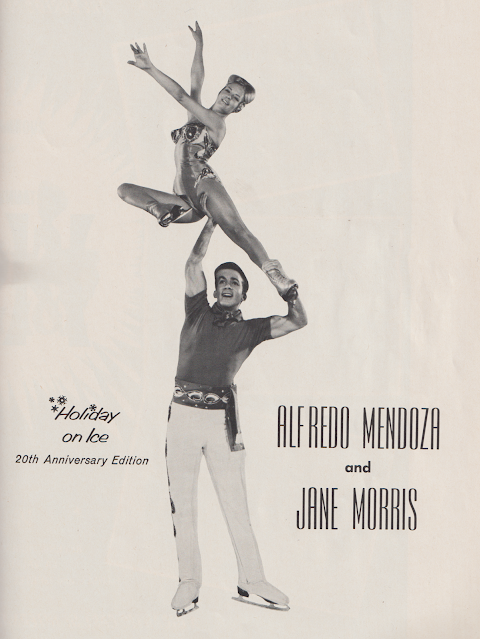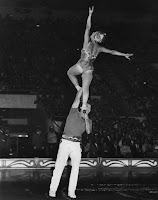Alfredo Mendoza and Jinx Clark. Photo courtesy "World Ice Skating Guide".
"I was burned out on skiing. I was doing it all the time and not making any money. It was fun to just glide along the ice. I was making money - and back then I was after the money." - Alfredo Mendoza, "The Tampa Tribune", August 23, 1995
Born January 9, 1933 in Acapulco de Juárez, Mexico, Alfredo Ortiz Mendoza grew up on the water. As a boy, he learned to swim and dive off the cliffs of La Quebrada and worked on a tugboat with his older brother Carlos. Alfredo and Carlos tried their hand at bullfighting in Mexico City but ultimately it was another sport that really caught Alfredo's fancy.
After seeing a newsreel of water skiers at a local theatre, Alfredo travelled to San Juan Bautista Tequesquitengo to learn the sport on the town's lake. A year later in 1950, when Dick Pope Jr. brought his water skiing troupe to the El Paradise beach club in Acapulco, Alfredo entered his first contest and placed a creditable fourth. He caught Dick's eye and was invited to participate in a series of competitions at Cypress Gardens in Florida.
With training, Alfredo quickly rose through the water skiing ranks and won the U.S. water ski jumping tournaments in 1952 and 1953. In 1953, he won the World title in Toronto, a feat he repeated two years later in Beirut, Lebanon. After turning professional, he staged a popular show at Cypress Gardens and endorsed a line of water skis - 'The Mendoza'. In a blurb regarding his 1989 induction to the International Waterski and Wakeboarding Hall of Fame, the sport's governing body noted, "His jumping wins were characterized by an unusual 'crack-the-whip' approach to the ramp, now known as the double-wake cut. Mendoza introduced it in 1951 after he and his fellow Cypress Gardens skiers had used it successfully in practice. It enabled him to set records at the world tournaments and later became a standard for water ski jumpers of all ages."
Photo courtesy Library of Congress
Alfredo's unlikely introduction to the sport of figure skating happened in 1955, when he was twenty years old. In a 1969 interview with a reporter from "The Tampa Tribune", he recalled, "Holiday on Ice was showing in Tampa that winter... and the star, Kay Servatius, came over to the Gardens to see them. She was gorgeous - a Ukrainian. I met her at the Gardens and she was interested in learning to water ski, which of course pleased me and Mr. Pope as well. I taught her, came to see the show at the Armoury... in Tampa and first laid eyes on an ice rink. After the show, I put on [a pair of rented] skates, got on the ice and promptly busted my confidence when I fell. I tried a couple of times, got interested and in the next few years, every chance I got, I went to Coral Gables where they had a rink and began learning to skate." The same reporter who interviewed him for that article called him a 'wetback'. Despite the discrimination he faced, Alfredo was so persistent in his efforts to learn to skate that he made the three and a half hour drive from Winter Haven to Coral Gables as often as he could. In 1957, he auditioned for Holiday On Ice and got his start in the chorus.
Photo courtesy "World Ice Skating Guide".
Alfredo's early days in the show were far from glamorous - at one point, he was selected to appear as the front half of a dog costume. Wearing a fifteen pound head, he careened around the ice to the strains of Elvis Presley's hit "Hound Dog". He recalled, "I couldn't skate worth a darn, but I was the world water ski champ. Publicity and all and they hired me. I was awful. I fell all the time. Twice, I guess, in one show was my personal record." Practicing every chance he could in between shows, he got his 'big break' when one of the male stars of the show was injured and he was picked out of fifty five other chorus skaters to replace him temporarily.
Left: Jinx Clark and Alfredo Mendoza. Right: Janie Morris and Alfredo Mendoza.
In the sixties, Alfredo became one of Holiday on Ice's biggest stars, skating adagio pairs acts with Tom Collins' future wife Janie Morris, Darolyn Prior, Carol Johnson and his own future wife, Jinx Clark. Alfredo's pairs act featured some of the most dazzling tricks of the trade, including gravity-defying carry lifts and the Detroiter. Many thought it was his skill on water skis translated to the ice, but he insisted the sports weren't similar whatsoever. "The skating is so much more difficult, really," he recalled. "Naturally, you don't have the help from the pull of the boat and the momentum for leaps and turns is all your own. Furthermore, there's always a possibility one of the girls in the show, or someone, might have dropped a bobby pin on the ice and that's some hazard."
Alfredo toured with Holiday on Ice until 1974 when, tired of the nomadic lifestyle of a touring professional, he returned to the water skiing world as a professional teacher. After returning to Cypress Gardens for a time, he operated his own water skiing schools in Clearwater and Tarpon Springs, supplementing his income by taking tourists out parasailing. In 1995, he told a reporter from "The Tampa Tribune" "I can't believe I've been doing it all this time, but it's great to be with people. I tell you, I love teaching. I think I'm a good teacher and I enjoy it."
Alfredo water-skiing in Tampa in 1995, just two years before his death
Alfredo passed away on March 21, 1997 in Clearwater, Florida at the age of sixty-four, leaving behind two sons - Carlos and Ricardo - and a legacy as the one of the only Latin American skaters to successfully make the transition from water to ice.
Skate Guard is a blog dedicated to preserving the rich, colourful and fascinating history of figure skating. Over ten years, the blog has featured over a thousand free articles covering all aspects of the sport's history, as well as four compelling in-depth features. To read the latest articles, follow the blog on Facebook, Twitter, Pinterest and YouTube. If you enjoy Skate Guard, please show your support for this archive by ordering a copy of the figure skating reference books "The Almanac of Canadian Figure Skating", "Technical Merit: A History of Figure Skating Jumps" and "A Bibliography of Figure Skating": https://skateguard1.blogspot.com/p/buy-book.html.
Skate Guard is a blog dedicated to preserving the rich, colourful and fascinating history of figure skating. Over ten years, the blog has featured over a thousand free articles covering all aspects of the sport's history, as well as four compelling in-depth features. To read the latest articles, follow the blog on Facebook, Twitter, Pinterest and YouTube. If you enjoy Skate Guard, please show your support for this archive by ordering a copy of the figure skating reference books "The Almanac of Canadian Figure Skating", "Technical Merit: A History of Figure Skating Jumps" and "A Bibliography of Figure Skating": https://skateguard1.blogspot.com/p/buy-book.html.







